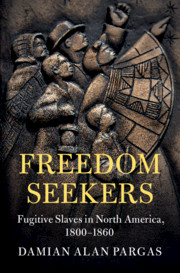Book contents
- Freedom Seekers
- Cambridge Studies on the American South
- Freedom Seekers
- Copyright page
- Contents
- Figures
- Acknowledgments
- Introduction
- 1 The Changing Geography of Slavery and Freedom
- 2 “Lurking amongst the Free Negroes”
- 3 “As If Their Own Liberty Were at Stake”
- 4 “Departure from the House of Bondage”
- Conclusion
- Bibliography
- Index
Conclusion
Published online by Cambridge University Press: 19 November 2021
- Freedom Seekers
- Cambridge Studies on the American South
- Freedom Seekers
- Copyright page
- Contents
- Figures
- Acknowledgments
- Introduction
- 1 The Changing Geography of Slavery and Freedom
- 2 “Lurking amongst the Free Negroes”
- 3 “As If Their Own Liberty Were at Stake”
- 4 “Departure from the House of Bondage”
- Conclusion
- Bibliography
- Index
Summary
The conclusion revisits the book's conceptualization of the geography of freedom in North America. It argues that the main differences between spaces of informal, semi-formal, and formal freedom for fugitive slaves come down to differences in freedom seekers' motivaitons, networks, visibility, and vulnerability. It is clear that runaways’ motivations and expectations of freedom from slavery tended to differ by degrees, and these informed their escape attempts. The networks that facilitated slave flight to all three spaces of freedom also differed by degrees, from family networks in spaces of informal freedom to more organized antislavery networks in spaces of semi-formal and formal freedom. Visibility was an important factor in slave flight. Freedom seekers in the urban South were the most dependent upon developing and cultivating false identities in order to prevent recapture; those who fled beyond the borders did not need to hide their identities at all. Finally, freedom seekers' vulnerability to recapture and reenslavement differed across the continent. Runaways in the urban South were the most vulnerable, whereas those who fled the United States were the least vulnerable.
Keywords
- Type
- Chapter
- Information
- Freedom SeekersFugitive Slaves in North America, 1800–1860, pp. 262 - 266Publisher: Cambridge University PressPrint publication year: 2021

